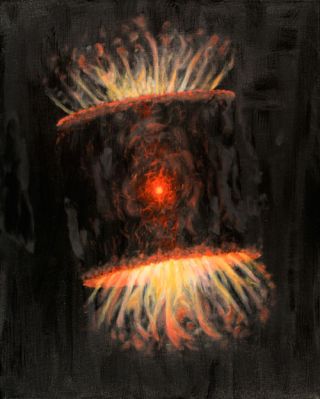 Stellar lifetimes are measured in billions of years, so changes in their appearance rarely take place on a human timescale. Thus an opportunity to observe a star passing from one stage of life to another on a timescale of months to years is very exciting, as there are only a very few examples known. One such star is Sakurai’s Object (V4334 Sgr). First reported by a Japanese amateur astronomer in 1996 as a “nova-like object,” Sakurai’s Object had been only a few years before the faint central star of a planetary nebula. In the 1990’s Sakurai’s Object brightened by a factor of 10000. This brightening has been attributed to a final helium shell flash. In this process the burned out core of the star at the center of the planetary nebula re-ignites.
Stellar lifetimes are measured in billions of years, so changes in their appearance rarely take place on a human timescale. Thus an opportunity to observe a star passing from one stage of life to another on a timescale of months to years is very exciting, as there are only a very few examples known. One such star is Sakurai’s Object (V4334 Sgr). First reported by a Japanese amateur astronomer in 1996 as a “nova-like object,” Sakurai’s Object had been only a few years before the faint central star of a planetary nebula. In the 1990’s Sakurai’s Object brightened by a factor of 10000. This brightening has been attributed to a final helium shell flash. In this process the burned out core of the star at the center of the planetary nebula re-ignites.
The final helium shell flash is violent, ejecting a cloud of dust and gas that forms a thick cocoon around the star blocking all visible light. By 2000 the dust cloud was so thick that Sakurai’s Object was not visible even with the Hubble Space Telescope (HST). Scientists at the National Optical Astronomy Observatory (NOAO) have been observing the sky in the area of Sakurai’s Object waiting for infrared radiation to break through the dust cloud. Infrared radiation penetrates dust much more efficiently than optical light. A detection of the infrared light would mean that the dust cloud is breaking apart, ultimately permitting light from the star to escape.
Read the full story at either Gemini or NOAO

